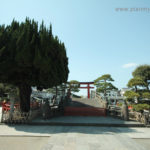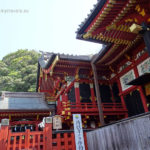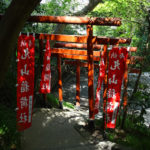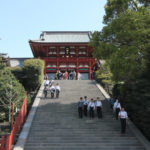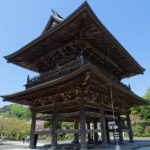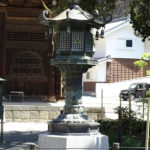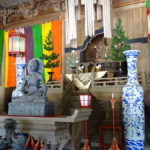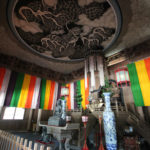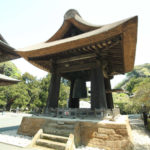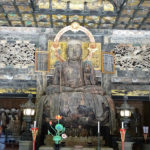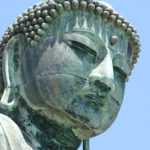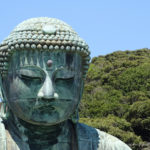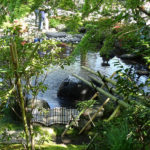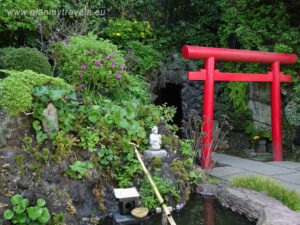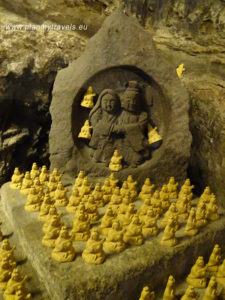History of Kamakura
Kamakura is an ancient city that over the centuries has produced its own, original culture. Although it was never the formal capital of Japan, for over 140 years (1192-1333), there was a centre of political power (along with Nara and Kyoto).
The first shogun of Japan was Minamoto no Yoritomo. Most of his family members died due to a long conflict between the Taira and Minamoto clans during the late – Heian period of Japan. Yoritomo survived, rebuilt the power of the Minamoto clan and defeated the Taira. Thanks to the numerous alliances and support of other clans of warriors, he became the most powerful man in the country. In 1192, by the decision of the emperor of Japan – Yoritomo was appointed as Seii-Taishogun (shogun), a leader who was holding full power.
He was not the first shogun in Japan, because there were several before him, but in opposite to his predecessors, the title of shogun was given to him for his whole life and was to be inherited. Yoritomo founded Kamakura first military government in Japan, Kamakura Bakufu, and chose the city to be his headquarters. Since that time, the emperor has become only a religious leader of divine origin.
Unfortunately, Yoritomo enjoyed his power only for a few years, as already in 1199 (seven years after receiving the title of the shogun), he has been betrayed and murdered. After Yoritomo’s death, the Hojo clan governed this area (the wife of Yoritomo was part of this family), and in the nearest future become a part of the family of Taira. In Japan, it was common to say that although Tairas lost the battle, in the end – they won the war. The Hojo government has ended in 1333, thus ending the period of military rule in Kamakura.
City development
In the twelfth century, there were over 60 religious buildings in the city. The Shogunate, the warrior community, and the military rigour made Kamakura the centre of Zen Buddhism at the end of the century. In the thirteenth century, more than 200,000 people lived there, and the city was the fourth largest in the world at that time. The town’s high attractiveness was defensively influenced by its unique location: from three sides it was surrounded by mountains, and from the four one – by waters of the Sagami Bay, belonging to the Pacific Ocean.
Kamakura began flourishing as a temple town in the 17th century. From the 19th century, it became popular for beaches, resort areas, and residential districts. Kawabata Yasunari, a writer who was awarded the Nobel Prize for Literature, lived and wrote many works in Kamakura. The city is blessed with the nature of the ocean and surrounding green hills. Kamakura today attracts many tourists. City rights were granted to Kamakura very late, in 1939 and today is known mainly for its temples.
Kamakura military culture
Soldiers who were leaving in Kamakura, daily were improving their war skills, so they ready to fight any time. Numerous military goods have been brought here from the whole country, such as precision armour, excellent swords and paintings of the war. Yabusame is a ritual in which a warrior riding on a galloping horse shot three shots at a target. This custom was born in Kamakura. The Yabusame festival is held every year in the Tsurugaoka-Hachimangu gardens on the last day of the Kamakura Festival (April) and in September.
Travel from Tokyo
In Tokyo, we took a JR Yokosuka train. Getting from Tokyo Station to Kamakura Station will take you 55 minutes. The train will stop on its way at a few main stations: Shinagawa, Yokohama or Kita-Kamakura stations.
From Kamakura station, we took a stroll. To the temple of Tsurugaoka Hachimangu, you can reach by passing thru the wide shopping street Wakamiya-Oji, 1.5 km long. It is a beautiful cherry avenue, leading through three torii gates. It was planted with numerous trees on the command of the Shogun Yoritomo, who wanted to honour the gods (kami) and to beg for a favour for his pregnant wife. In the middle of the street, there is a wide alley along with numerous stone lanterns. The temple is also accessible by a parallel street – Komachi-dori, which offers the opportunity to view old wooden houses, multi-generational shops, or small, backyard Japanese gardens. We have decided to go to the temple along the less popular street, which is more authentic and natural.
Kamakura temples
Tsurugaoka Hachimangu
This temple was founded in 1063 by Minamoto no Yoriyosji as a branch of the temple of Iwashimizu Hachimangu located in Kyoto. Originally, Tsurugaoka Temple was built near the Yuigahama coast. In 1180, however, it was moved to the present location by the future shogun, Minamoto no Yoritomo. He wanted this temple to be the main one, in the city he has founded.
Before leaving the temple, we visited a small nearby park with a pond and very tame, big, grey squirrels.
Kencho-Ji Temple
Then, we went to the Kencho-ji Temple (about 700m, on foot, along the main road, slightly up the hill). It was built in the year 1253, at the behest of Emperor Gofukakus during the reign of the Hojo family. Construction works ended in the fifth year of the Kencho era, from which the name of the temple was given.
Originally, there were 7 main buildings and 49 smaller temples. Unfortunately, at the turn of the 14th and 15th centuries, most of them were destroyed due to numerous fires. In the years 1573 – 1645, Takuan – the Zen Master, asked the Kamakura shogun for financial help. This has allowed him to rebuild the temple in its original form, which can be admired to this day. Today there are several main buildings (main temple, monastery, gate and belfry) and 10 smaller temples. It is the most important Zen temple in Japan and the oldest Zen monastery.
Kotokuin Temple (Great Buddha)
After returning to Kamakura station, we took a city bus (Enoshima Dentetsu Bus), departing from the 1st position (Suica / PASMO card). The bus goes for about 15 minutes and stops literally opposite the entrance to the temple. Note, the bus is not suitable for tourists, as there is no information in English, it is difficult to know where it is and whether it is going in the right direction. The bus driver speaks the names of each bus stop (in Japanese), so please listen well and get off at the bus stop called Daibatsu-mae. For me, travel by this bus was itself a kind of attraction :-).
The temple can also be reached by Enoden train (3 train stations from Kamakura to Hase), but from the Hase station, you have to walk by another 7 minutes.
Sitting Buddha Amida, also known as Kamakura Daibatsu (Great Buddha) is the biggest attraction of the city and the National Treasure. Measuring 11.3 meters (including the base – 13.4 meters) and weighing 121 tons statue, is made of bronze. It was founded in 1252 and its creation took about 10 years. His construction was ordered by the wife of the Yoritomo (shogun), following the great statue of Todai-Ji in Nara, depicting the Buddha of Wajrahan. At that time, the statue of the Buddha was made of wood and stood on the temple grounds in 1243. Less than five years after its ascension, the statue was taken by a typhoon and never found back. Another sculpture was made of bronze and covered with gold petals.
The statue inside is empty, so you can go inside (with a symbolic ticket price) and see the handmade work done more than 750 years ago.
Originally, for several decades the monument stood inside a wooden pavilion (the great Buddha hall). Unfortunately – it was destroyed twice by the tsunami (1334 and 1369) and then by the earthquake (1498). After these events, the pavilion has never been rebuilt, so now it is an outdoor Daibatsu.
Today, there are few traces of Buddha’s gilding left, but its dimensions continue to make a big impression on visitors. To emphasize the scale of its size: the face measures 2.35 m, the eyes have 1 m and the ears are 1.9 m long.
The entrance to the temple area of 200 yen (about 1,6 Euros), and the entrance to the monument – is 20 yen (0.2 Euros).
Hasedera temple
On our way back to Hase railway station, we decided to visit one more place: the Bodhisattva Temple of Kannon-Hasedera.
According to legend, in 721 AD the pious monk Tokudo Shonin discovered a large camphor tree, in the woods near the village of Hase, in the Nara region. He carved out two statues of the goddess Kannon with 11 faces. The first monument made from the lower part of the tree was placed in the temple in Nara. The second monument (made from the top of the tree) was thrown into the sea, praying to float up to the place where people need bodhisattva care. Apparently, the second statue was found 15 years later, on one of the beaches near Kamakura. To honour it, the temple of Hase was constructed, in which the monument Kannon stands today.
I think this place is absolutely worth visiting. You should plan to spend there at least 2-3 hours, to have enough time for a visit and relax. The temple is situated on a hill, and it is surrounded by beautiful gardens. There are several interesting places to visit: temples, statues of saints, caves, small Jizo figurines and beautiful small gardens. The best is at the end: a marvellous view of the bay and ocean waters.
- Kannon-do hall is a place where a magnificent statue of Hase Kannon is housed. It is made of wood and covered with gold leaf (added in 1342). “The Buddhist Goddess of Mercy” has 11 heads (on top of the main one) and is over 9m high. It is the largest monument of this Goddess in Japan. The goddess is depicted as a woman holding a stick in her right hand and a lotus flower in her left hand, but strictly speaking, it is neither masculine nor feminine. Unfortunately, I do not have a photo, because, within the temple where the monument is located, there is a ban on taking photos.
- Amida-do Hall, where a golden seated statue of Yakuyoke, the Protector from Evil Spirits, Amida Buddha, is enshrined. It was built at the command of Minamoto no Yoritomo (first shogun), in 1194 Ad, and measures 2.8 meters in height.
- Jizo-do Hall. There is a small building, in which Fukuju Jizo, or “Happy” Jizo, is enshrined. Surrounding the Hall are thousands of little Jizo stone statues standing in long rows. The statues are there to comfort the souls of unborn children and help them on the way to paradise.
Benten-kutsu Cave
There is a little cave hewn into the rock, where Benzaiten and 16 children are chiselled out of the rock walls. Benzaiten is a sea goddess and the only female among the Seven Lucky Gods of Japan. Her temples and shrines are located near water–the sea, a river, or a pond. She is the patron of music, the fine arts, and good fortune in general, and usually carries a biwa (Japanese mandolin) or plays the lute. Be careful inside the cave. It is dark and the ceiling is low, so watch your step. There are many votive candles burning everywhere, which makes the place magical.
Entrance ticket to the Hasedera temple 300 Jen (2,4 euros).
I recommend finishing your visit to the Hasedera Temple, on the scenic terrace. You can sit there, have some snacks or buy something to drink from a nearby beverage machine, but above all: enjoy the beautiful view of Sagami Bay, the sandy beaches and the ocean. Beware of the Kites who learned to steal food straight from the tourists’ plates. There are numerous information boards warring about it, so it is easy to remember.
Return to Hase Station (about 5 minute’s walk), train Enoden Line to Kamakura Station (3 stations).
On the way back to Tokyo, visit Chinatown and Yokohama. Please note that Tokyo and its districts I will describe in a separate post.
Useful links
- official website of the Hasedera Temple
- Kannon Musem (pdf)
- Kamakura City
- Kamakura Visitors Guide
- official website of the Tsurugaoka Hachimangu Temple
- Kamakura, Odawara & Enoshima 1 Day Tour*
- Kamakura Essential Walking Tour + Local Experience from Tokyo*
So far, my other posts about Japan:
- Japan – how to organise the trip on your own
- Japan – tailor-made travel plan
- my own gallery of Japan photos
TRIPS:
- Himeji – White Egret Castle
- Kamakura – the seat of the first Shogun
- Kanazawa – Kenrokuen Garden and Castle
- Kyoto and Kansai region
- Matsumoto – city overshadowed by the castle
- Mount Fuji – the most popular icon in Japan
- Nagano Prefecture – the roof of Japan
- Nara -first Japan’s permanent capital
- Nikko – the light of the sun
- Tokyo – western capital
*links to the offer from Klook are affiliate








